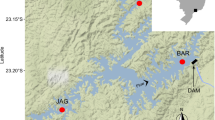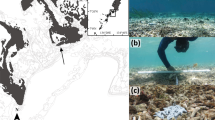Abstract
The barnacle, Balanus glandula has recently invaded along the Pacific coast of eastern Hokkaido, Japan. To evaluate the direct and indirect effects of endemic seaweeds, barnacles, and invertebrate predators on the abundance of B. glandula on the rocky intertidal coast of eastern Hokkaido, we conducted a field experiment from June 2011 to October 2012 in which we manipulated the presence or absence of these factors. Seaweeds showed no significant effect on the abundance of B. glandula. The endemic barnacle Chthamalus dalli and the invertebrate predator Nucella lima reduced the abundance of B. glandula. However, the simultaneous influence of N. lima and C. dalli was compensative rather than additive, probably due to keystone predation. These findings suggest that competition by the endemic barnacle C. dalli and predation by the invertebrate predator N. lima decreased the abundance of B. glandula, but that N. lima predation on C. dalli weakened the negative influence of C. dalli on B. glandula. The implications of these findings are twofold: the endemic competitor and invertebrate predator may have played important roles in decreasing the abundance of B. glandula in natural habitats, and conservation of endemic invertebrate predators may be crucial to impede the establishment and survival of introduced barnacles in rocky intertidal habitats.




Similar content being viewed by others
References
Abrams P, Menge BA, Mittelbach GG, Spiller D, Yodzis P (1996) The role of indirect effects in food webs. In: Polis G, Winemiller K (eds) Food webs: integration of patterns and dynamics. Chapman and Hall, New York, pp 371–395
Alam AKMR, Hagino T, Fukaya K, Okuda T, Nakaoka M, Noda T (2014) Early phase of the invasion of Balanus glandula along the coast of Eastern Hokkaido: changes in abundance, distribution, and recruitment. Biol Inv 16:1699–1708
Allen BM, Power AM, O’Riordan RM, Myers AA, McGrath D (2006) Increases in the abundance of the invasive barnacle Elminius modestus Darwin in Ireland. Biol Environ Proc Roy Irish Acad 106:155–161
Altieri AH, Wesenbeeck BKV, Bertness MD, Brian R (2010) Facilitation cascade drives positive relationship between native biodiversity and invasion success. Ecology 91:1269–1275
Barnett BE (1979) A laboratory study of predation by dogwhelk Nucella lapillus on the barnacles Elminius modestus and Balanus balanoides. J Mar Biol Assoc UK 59:299–306
Berlow EL (1999) Strong effects of weak interactions in ecological communities. Nature 398:330–334
Bertness MD, Leonard GH, Levine JM, Schmidt PR, Ingraham AO (1999) Testing the relative contribution of positive and negative interactions in rocky intertidal communities. Ecology 80:2711–2726
Carlton JT, Newman WA, Pitombo FB (2011) Barnacle invasions: introduced, cryptogenic, and range expanding Cirripedia of North and South America. In: Galil BS, Clark PF, Carlton JT (eds) In the wrong place—alien marine crustaceans: distribution, biology and impacts, invading nature, Springer Series in Invasion Ecology 6. Springer Verlag, Berlin, pp 159–213
Connell JH (1970) A predator-prey system in the marine intertidal region. 1. Balanus glandula and several predatory species of Thais. Ecol Monogr 40:49–78
Dayton PK (1971) Competition, disturbance, and community organization: the provision and subsequent utilization of space in a rocky intertidal community. Ecol Monogr 41:351–389
Denley EJ, Underwood AJ (1979) Experiments on factors influencing settlement, survival, and growth of two species of barnacles in New South Wales. J Exp Mar Biol Ecol 36:279–293
Dumont CP, Gaymer CF, Thiel M (2011) Predation contributes to invasion resistance of benthic communities against the non-indigenous tunicate Ciona intestinalis. Biol Inv 13:2023–2034
Farrell TM (1991) Models and mechanisms of succession: an example from a rocky intertidal community. Ecol Monogr 61:95–113
Fukaya K, Okuda T, Hori M, Yamamoto T, Nakaoka M, Noda T (2013) Variable processes that determine population growth and an invariant mean-variance relationship of intertidal barnacles. Ecosphere 4:1–20 (Art 48)
Geller JB, Sotka EE, Kado R, Palumbi SR, Schwindt E (2008) Sources of invasions of a northeastern Pacific acorn barnacle, Balanus glandula, in Japan and Argentina. Mar Ecol-Prog Ser 358:211–218
Harley CDG, O’Riley JL (2011) Non-linear density-dependent effects of an intertidal ecosystem engineer. Oecologia 166:531–541
Hori M, Noda T (2001) Spatio-temporal variation of avian foraging in the rocky intertidal food web. J Anim Ecol 70:122–137
Jara HF, Moreno CA (1984) Herbivory and structure in midlittoral rocky community: a case in Southern Chile. Ecology 65:28–38
Jernakoff P (1985) The effect of overgrowth by algae on the survival of the intertidal barnacle Tesseropora rosea Krauss. J Exp Mar Biol Ecol 94:89–97
Kado R (2003) Invasion of Japanese shores by the NE Pacific barnacle Balanus glandula and its ecological and biogeographical impacts. Mar Ecol-Prog Ser 249:199–206
Laird MC, Griffiths CL (2008) Present distribution and abundance of the introduced barnacle Balanus glandula Darwin in South Africa. Afr J Mar Sci 30:93–100
Leonard GH (2000) Latitudinal variation in species interactions: a test in the New England rocky intertidal zone. Ecology 81:1015–1030
Leonard GH, Ewanchuk PJ, Bertness MD (1999) How recruitment, intraspecific interactions and predation control species borders in a tidal estuary. Oecologia 118:492–502
Menge BA (1972) Competition for food between two intertidal starfish species and its effects on body size and feeding. Ecology 53:635–644
Menge BA (1976) Organization of the New England rocky intertidal community: role of predation, competition and environmental heterogeneity. Ecol Monogr 46:355–393
Menge BA (1978) Predation intensity in a rocky intertidal community. Oecologia 34:17–35
Menge BA (1995) Indirect effects in marine rocky intertidal interaction webs: patterns and importance. Ecol Monogr 65:21–74
Menge BA (1997) Detection of direct versus indirect effects: were experiments long enough? Am Nat 149:801–823
Menge BA, Berlow EA, Blanchette CA, Navarrete SA, Yamada SB (1994) The keystone species concept: variation in interaction strength in a rocky intertidal habitat. Ecol Monogr 64:249–286
Munroe DM, Noda T (2010) Physical and biological factors contributing to changes in the relative importance of recruitment to population dynamics in open populations. Mar Ecol-Prog Ser 412:151–162
Nakaoka M, Ito N, Yamamoto T, Okuda T, Noda T (2006) Similarity of rocky intertidal assemblages along the Pacific coast of Japan: effects of spatial scales and geographic distance. Ecol Res 21:425–435
Navarrete SA (1996) Variable predation: effects of whelks on a mid-intertidal successional community. Ecol Monogr 66:301–321
Noda T, Minamiura N, Miyamoto Y (2003) Seasonal changes in an intertidal annual algal assemblage in northern Japan: the role of pre-emption and grazing on algal replacement. Ecol Res 18:695–709
Okuda T, Noda T, Yamamoto T, Ito T, Nakaoka M (2004) Latitudinal gradient of species diversity: multi-scale variability in rocky intertidal sessile assemblages along the northeast Pacific coast. Popul Ecol 46:159–170
Palmer AR (1984) Prey selection by thaidid gastropods: some observational and experimental field tests of foraging models. Oecologia 62:162–172
Petren K, Case TJ (1996) An experimental demonstration of exploitation competition in an ongoing invasion. Ecology 77:118–132
Poloczanska ES, Hawkins SJ, Southward AJ, Burrows MT (2008) Modeling the response of populations of competing species to climate change. Ecology 89:3138–3149
R Development Core Team (2011) R: a language and environment for statistical computing. R Foundation for Statistical Computing, Vienna
Reusch TBH (1998) Native predators contribute to invasion resistance to the non-indigenous bivalve Musculista senhousia in Southern California. Mar Ecol-Prog Ser 170:159–168
Schoener TW, Spiller DA (1995) Effect of predators and area on invasion: an experiment with island spiders. Science 267:1811–1813
Schwindt E (2007) The invasion of the acorn barnacle Balanus glandula in the south-western Atlantic 40 years later. J Mar Biol Assoc UK 87:1219–1225
Simkanin C, Dower JF, Filip N, Jamieson G, Therriault TW (2013) Biotic resistance to the infiltration of natural benthic habitats: examining the role of predation in the distribution of the invasive ascidian Botrylloides violaceus. J Exp Mar Biol Ecol 439:76–83
Southward AJ, Burton RS, Coles SL, Dando PR, DeFelice RC, Hoover J, Parnell PE, Yamaguchi T, Newman WA (1998) Invasion of Hawaiian shores by an Atlantic barnacle. Mar Ecol-Prog Ser 165:119–126
Stachowicz JJ, Byrnes JJ (2006) Species diversity, invasion success, and ecosystem functioning: disentangling the influence of resource competition, facilitation, and extrinsic factors. Mar Ecol-Prog Ser 311:251–262
Stachowicz JJ, Fried H, Osman RW, Whitlatch RB (2002) Biodiversity, invasion resistance, and marine ecosystem function: reconciling pattern and process. Ecology 83:2575–2590
Stanley SM, Newman WA (1980) Competitive exclusion in evolutionary time: the case of the acorn barnacles. Paleobiology 6:173–183
Underwood AJ, Denley EJ, Moran MJ (1983) Experimental analyses of the structure and dynamics of mid-shore rocky intertidal communities in New South Wales. Oecologia 56:202–219
West L (1986) Interindividual variation in prey selection by the snail Nucella (=Thais) emarginata. Ecology 67:798–809
White EM, Wilson JC, Clarke AR (2006) Biotic indirect effects: a neglected concept in invasion biology. Divers Distrib 12:443–455
Winer BJ (1971) Statistical principles in experimental designs, 2nd edn. McGraw-Hill, Kogakusha
Acknowledgments
We thank Masahiro Nakaoka for his assistance and advice regarding this experiment. We also thank Tomoaki Hagino, Keiichi Fukaya, and Mituho Iida for their help in setting up the field experiment. We are grateful to member of the Akkeshi Marine Laboratory for their assistance with transportation to the study site. This research was supported by the Akkeshi Waterfowl Observation Center. Financial support was provided to AKMRA in the form of a scholarship entitled “Special Grants Program for International Students to perform Doctoral Research” by Hokkaido University, and was partly supported by JSPS KAKENHI Grant (Nos. 24570012 and 15K07208 to TN).
Author information
Authors and Affiliations
Corresponding author
Rights and permissions
About this article
Cite this article
Rashidul Alam, A.K.M., Noda, T. An experimental evaluation of the direct and indirect effects of endemic seaweeds, barnacles, and invertebrate predators on the abundance of the introduced rocky intertidal barnacle Balanus glandula . Popul Ecol 58, 507–514 (2016). https://doi.org/10.1007/s10144-016-0554-1
Received:
Accepted:
Published:
Issue Date:
DOI: https://doi.org/10.1007/s10144-016-0554-1




